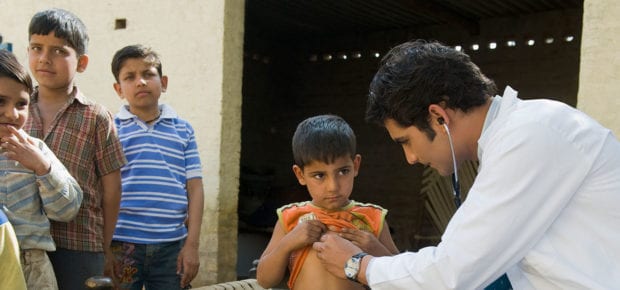November 22, 2019
For many in the world, access to premium healthcare and wellness services are not easily attainable. Inconsistencies in medical diagnoses, long travel times to hospitals and lack of resources often make it difficult for rural patients to receive the care they desperately need.
“We need to bring technology to the user, and avoid the danger that such technology will only be affordable by a small percentage of people ” says IEEE member Kerstin Dautenhahn. “We need low-cost solutions that are ideally freely available to all. That’s my personal vision.”
Luckily, new health technologies are emerging to someday help provide more well-rounded access. We asked our IEEE Impact Creators to share their insights on the AI-focused technologies they believe will limit the healthcare gap in the future.
1. Sensor Technologies
“Currently, the range and quality of healthcare is inconsistent,” says IEEE Fellow Karen Panetta. “In some cases people go into hospitals for one ailment and come out with other ailments that were introduced by unsanitary conditions or resulting from poor communication or misunderstanding of patient cases.
“Artificial intelligence and new sensor technology will help break this vicious cycle, by introducing new technology to detect bacteria such as staph infections and ensure that health workers remain compliant with safety protocols,” says Panetta.
2. Telehealth and Digital Calling
Physical location is often a big deterrent for rural patients to receive the care they need. In large countries like China, patients must commute days and pay a large sum of money for the transit. Now with technologies like telehealth and digital calling, a patient has the ability to quickly see top doctors without having to make a physical trip.
“Providing care untethered from a physical location means a child in Sumter county, Alabama can potentially be seen by a pediatric cardiologist at Rainbow Babies and Children’s hospital, and referred to a consultation later the same day by a pediatric cardiothoracic surgeon at Children’s Hospital of Pennsylvania,” says IEEE member Doug Walled.
Telehealth is also a great way for doctors to come together and work to solve rare diseases or illnesses.
“Along with remote diagnosis, physicians are able to effectively utilise their time to be spent with multiple patients from multiple geographies,” says IEEE member Jayakrishnan Thrivikraman Nair. “This will also enable a pool of experts from various locations to collectively address a problem and make decisions when it comes to complicated issues.”
3. Wearable Technologies
Wearable technologies are great for daily maintenance to check vitals. As these watches and other wearables become more accessible, patients in rural areas will be able to easily track their health and send their data to a healthcare professional to update their charts.
“More and more it is a question of scalability and quality of care,” says IEEE member Antonio Espingardeiro. “As the worldwide population increases we will need to monitor our health through different ways. We will need more periodic checks and doing it through daily routines almost in an unconscious way.”
As these three technologies continue to advance and become more accessible, rural patients will be able to receive the type of care they desperately need, without the hefty price tag associated with it.





 Quantum and AI: Safeguards or Threats to Cybersecurity?
Quantum and AI: Safeguards or Threats to Cybersecurity? Why AI Can't Live Without Us
Why AI Can't Live Without Us Bits, Bytes, Buildings and Bridges: Digital-Driven Infrastructure
Bits, Bytes, Buildings and Bridges: Digital-Driven Infrastructure Impact of Technology in 2024
Impact of Technology in 2024 Emerging AI Cybersecurity Challenges and Solutions
Emerging AI Cybersecurity Challenges and Solutions The Skies are Unlimited
The Skies are Unlimited Smart Cities 2030: How Tech is Reshaping Urbanscapes
Smart Cities 2030: How Tech is Reshaping Urbanscapes Impact of Technology 2023
Impact of Technology 2023 Cybersecurity for Life-Changing Innovations
Cybersecurity for Life-Changing Innovations Smarter Wearables Healthier Life
Smarter Wearables Healthier Life Infrastructure In Motion
Infrastructure In Motion The Impact of Tech in 2022 and Beyond
The Impact of Tech in 2022 and Beyond Cybersecurity, Technology and Protecting Our World
Cybersecurity, Technology and Protecting Our World How Technology Helps us Understand Our Health and Wellness
How Technology Helps us Understand Our Health and Wellness The Resilience of Humanity
The Resilience of Humanity Harnessing and Sustaining our Natural Resources
Harnessing and Sustaining our Natural Resources Creating Healthy Spaces Through Technology
Creating Healthy Spaces Through Technology Exceptional Infrastructure Challenges, Technology and Humanity
Exceptional Infrastructure Challenges, Technology and Humanity The Global Impact of IEEE's 802 Standards
The Global Impact of IEEE's 802 Standards Scenes of our Cyber Lives: The Security Threats and Technology Solutions Protecting Us
Scenes of our Cyber Lives: The Security Threats and Technology Solutions Protecting Us How Millennial Parents are Embracing Health and Wellness Technologies for Their Generation Alpha Kids
How Millennial Parents are Embracing Health and Wellness Technologies for Their Generation Alpha Kids Space Exploration, Technology and Our Lives
Space Exploration, Technology and Our Lives Global Innovation and the Environment
Global Innovation and the Environment How Technology, Privacy and Security are Changing Each Other (And Us)
How Technology, Privacy and Security are Changing Each Other (And Us) Find us in booth 31506, LVCC South Hall 3 and experience the Technology Moon Walk
Find us in booth 31506, LVCC South Hall 3 and experience the Technology Moon Walk Virtual and Mixed Reality
Virtual and Mixed Reality How Robots are Improving our Health
How Robots are Improving our Health IEEE Experts and the Robots They are Teaching
IEEE Experts and the Robots They are Teaching See how millennial parents around the world see AI impacting the lives of their tech-infused offspring
See how millennial parents around the world see AI impacting the lives of their tech-infused offspring Take the journey from farm to table and learn how IoT will help us reach the rising demand for food production
Take the journey from farm to table and learn how IoT will help us reach the rising demand for food production Watch technical experts discuss the latest cyber threats
Watch technical experts discuss the latest cyber threats Explore how researchers, teachers, explorers, healthcare and medical professionals use immersive technologies
Explore how researchers, teachers, explorers, healthcare and medical professionals use immersive technologies Follow the timeline to see how Generation AI will be impacted by technology
Follow the timeline to see how Generation AI will be impacted by technology Learn how your IoT data can be used by experiencing a day in a connected life
Learn how your IoT data can be used by experiencing a day in a connected life Listen to technical experts discuss the biggest security threats today
Listen to technical experts discuss the biggest security threats today See how tech has influenced and evolved with the Games
See how tech has influenced and evolved with the Games Enter our virtual home to explore the IoT (Internet of Things) technologies
Enter our virtual home to explore the IoT (Internet of Things) technologies Explore an interactive map showcasing exciting innovations in robotics
Explore an interactive map showcasing exciting innovations in robotics Interactively explore A.I. in recent Hollywood movies
Interactively explore A.I. in recent Hollywood movies Get immersed in technologies that will improve patients' lives
Get immersed in technologies that will improve patients' lives